World of Tanks news » The Chieftain's Hatch: US Guns, German Armour, Pt 1
US ARMY ANTI-ARMOR FIRING TESTS OF 1944

In the summer of 1944 the US Army forces in the European Theater of Operations (ETO) conducted a series of test-firings that are much quoted to this day by researchers and wargamers. These test-firings disputed the official line on the effectiveness of the guns and ammunition being provided by the Army's Department of Ordnance, and provided substantive feedback that changed some of the long-held assumptions and methods of Ordnance testing and specifications.
There were a total of four test shoots:
1) Shoeburyness, UK; 23 May, 1944: Demonstration firing to observe effectiveness of new US 76mm, 90mm and British 17pdr guns.
2) Balleroy, France; 10 July, 1944: Impromptu test of 17pdr APDS rounds against Panther tank
3) Isigny, France; 12 – 30 July, 1944: 1st US Army test of all available anti-armor weapons against Panther tank
4) Isigny, France; 20 – 21 August, 1944: 12 Army Group comparative test of US 76mm and British 17pdr ammunition against Panther tank, including new US HVAP ammunition
BACKGROUND: THE PANTHER CRISIS OF JULY, 1944
The US Army forces in the ETO went through a flurry of testing for one primary reason: The Panther tank.
The Panther tank came as a shock to US forces in the days after the Normandy invasion. Not that the Panther was unheard-of before D-Day. But somehow, the substantial information on the characteristics of the new German tank that were available to the US Army had not been correctly interpreted, and so its combat capabilities and its impact on operations had not been anticipated.
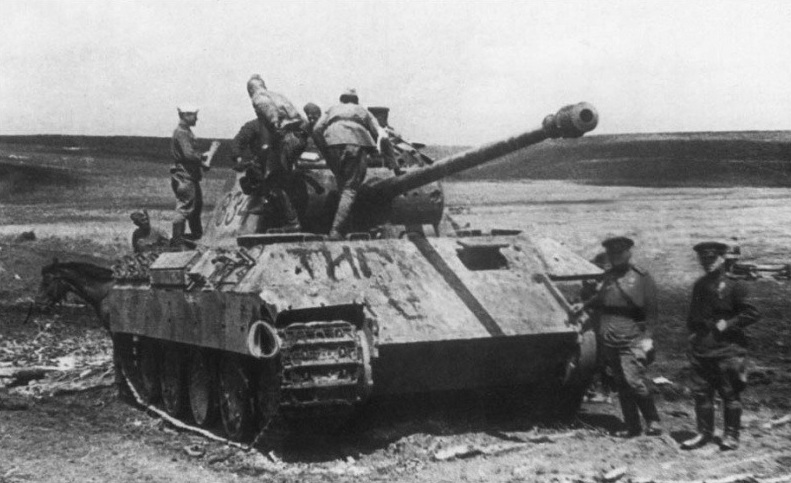
The Pz V Panther was first mentioned in the War Department publication “Tactical and Technical Trends” on 4 November, 1943. This report was based on information provided by the Soviets, as the Western allies had not yet met any Panthers in combat. The Soviets had captured or recovered several Panthers after the great armored battles of Kursk and their subsequent great advances across the Ukraine in the summer of 1943. While their reports to the Western allies had ample doses of propaganda on the effectiveness of Soviet weapons (in the hands of heroic Red Army soldiers, of course), they also provided very accurate technical information on the Panther, including comprehensive measures of armour thickness and slope, gun velocity and penetration, and automotive performance. The Soviets indicated that Panthers had better mobility than Tigers, but were notably easier to knock-out.
The US interpretation of the data was that it was an “intermediate” design, more like an M4 Sherman than prior German tanks:
It appears to be an intermediate type between the 22-ton PzKw 4 and the PzKw 6 (Tiger) tank. ... It approximates (corresponds roughly to) our General Sherman, a tank which evoked complimentary comment in the Nazi press.
The Soviets reported that Panthers were organized into separate battalions, as were Tiger tanks, rather than being integrated into the Panzer Regiments of the Panzer Divisions. This suggested to the US Army that it was not a mainstream design.
The next mention occurred in the January, 1944 issue of "Intelligence Bulletin". This publication repeated much of the same information, but now characterized the Panther as a heavy tank. This theme was repeated in the February, 1944 issue of the Journal of Recognition http://www.lonesentry.com/ferdinandpanther/index.html, which stated:
A new heavy tank in the German arsenal, the 45-ton PzKw Mark V series to bridge the gap between the 22-ton Mark IV and the 60-ton Mark VI, Tiger. This tank, which is called the Panther, appears to be a first-class vehicle, fast, well-armored and hard-hitting. It has the advantage of being swifter and more maneuverable than the Tiger but at the same time is easier to knock out because of lighter armor protection.
These reports included accurate measures of the Panther’s frontal armor. And they described the vehicle as being well-armoured. But they also suggested it was comparable to the M4, and noted that it was considered easier to knock-out than the Tiger. Also, they had come to characterize the Panther as a heavy tank … a tank that would be seen, like Tigers, only on rare occasions. The Panther was a Tiger that was easier to kill. No where was there any suggestion that a problem was brewing. No there was no expression of concern that the Panzer Divisions were now being re-equipped with a standard medium tank that was immune across its frontal arc to all of the anti-tank weapons then in service with US forces.
This alarming development would only be made glaringly obvious in combat in Normandy in the weeks following D-Day.
THE SHOEBURYNESS TESTS: 23 MAY, 1944
In the weeks before D-Day a demonstration test-firing was held for US Army commanders at Shoeburyness, in Essex, England. Ordnance had recently provided ETO with a rush shipment of 100 M4A1 tanks equipped with a new turret and the new M1A1 76mm gun. Ordnance had also developed a new tank gun from the M1 90mm AA gun – the M3 90mm gun, and since the spring of 1943 had been re-arming a total of 500 M10A1 tank destroyers with a new turret mounting this gun. In June of 1944 these re-armed tank destroyers would be standardized as the M36 Gun Motor Carriage
The firing test was organized to allow a selection of officers from ETO to observe and compare the firepower of these new and upcoming weapons. The 17pdr (76.2mm) AT gun, now coming into wide-spread use in the British forces of ETO, was also added to the test firing, as well as the then-current 75mm gun, which equipped both US M4 tanks (as 75mm gun M3) and British tanks (75mm QF Mk. V).
The test program consisted of a total of 15 shots, taken in three phases.
Phase 1: The 17pr, 76mm M1, and 90mm M1 guns were fired against test plates 120mm thick, at a slope of 30º, at ranges of 800, 400, and 100 yards, to determine their comparative effectiveness.
Phase 2: The 17pdr, 76mm, and 90mm guns were fired against test plates 100mm thick, at a slope of 30º, which was backed by another vertical plate 100mm thick, at a range of 500 yards, to determine the behind-armor effects of the rounds.
Phase 3: The 75mm Mk V gun, using American M61 APC ammunition, was fired against test plates 20mm thick, placed 6 inches in front of test plates 50mm thick, both at a slope of 30º, to test the effectiveness of the round against spaced armor. In this test half of the rounds were fired either with their explosive filler (referred to as “shell”), or with the filler and the base-detonating fuse removed (referred to as “shot”). This would be a test to validate the capability of the 75mm against a MkIV equipped with Vorpanzer.
The tests were conducted against US test-plate, which was 240 BHN (Brinnel Hardness) homogenous rolled steel. On the original report, the reference to homogenous plate is crossed-out, and “face-hardened” is hand-written in for the 50mm plate of the Phase 3 tests. This is presumed to refer to the actual test plates, but it could instead reflect the interests of some reviewer, as Germans used face-hardened armour.
The results of the tests are as follows:
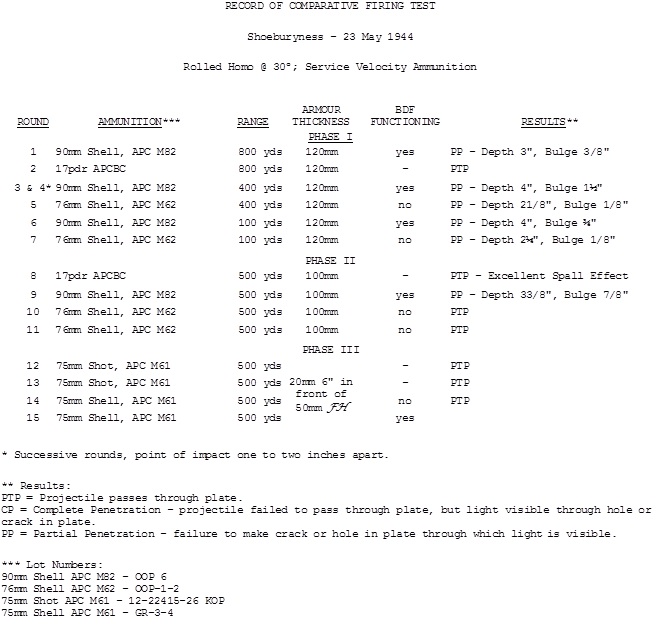
The tests showed the superior penetration of the British 17pdr. They also indicated a tendency for US shells to explode before passing through the target armour (a “yes” in the column titled BDF Functioning indicates that the fusing caused the shell to detonate, an event which is highly correlated with failure of the round to pass through the plate).
The tests led to the stated conclusion that shot held no particular advantages over shell, but that the base-detonated fuses of US AP rounds had a tendency to detonate the rounds prematurely. A memorandum was sent from ETO to Ordnance, under Eisenhower’s signature, calling for an immediate remedy to the fusing, or if that wasn’t possible calling for all further AP ammunition to ETO to be provided un-fused with an inert filler.
Perhaps more important was what was left unstated. First there was evident concern to ensure that the 75mm gun on Sherman could handle the Pz IV, a clear indication of what German tanks the Army was expecting to face. Second was that the tests gave evidence (and confidence) that the new 76mm gun available on the Sherman, as well as the 3-inch gun on the M10 (which fired the same projectiles and was a ballistic match to the 76mm M1 gun), would penetrate 100mm of German armor at 30º at reasonable combat ranges, allowing these vehicles to handle the occasional Tiger (100mm hull front) or Panther (80mm at 55º), should they appear.
US Army commanders were so confident in their guns, and so complacent about the risks posed by the Panzers, that there was no call for 90mm-armed vehicles, no recommendation for further up-gunning beyond the 76mm gun, and no call for improved penetration for the existing ammunition (beyond fixing the fuses). British offers of the 17pr were politely declined as unnecessary. So complacent were the US commanders, in fact, that the 100 up-gunned Shermans with 76mm guns that had been rushed to the ETO were turned down by unit commanders as being an un-necessary complication to their logistics and training, and were left behind in the UK on D-Day.
That attitude changed quickly after 6 June.
THE BALLEROY TEST: 10 JULY, 1944
Once armoured units got off of the beaches of Normandy and into the bocage country, they were confronted by the reality of the Panzers. Attacking up narrow roads confined by dense raised hedgerows, or facing their enemies across the hedge-lined farm fields, Allied tankers were stuck with little room to maneuver, and faced many occasions where head-on gunfire exchanges was their only option. In these cases Allied armor, and US tank formations in particular, seemed to come off poorly. Tigers were not quite as rare as expected. More importantly Panthers were not rare at all.
The 75mm gun on the M4 was woefully inadequate to facing either a Tiger or a Panther frontally. So by late June the cry went out for the M4(76)s in the UK to be shipped to France for issue to the medium battalions.
Unfortunately, the new up-gunned Shermans did little to redress the problem. Despite what was shown on Ordnance Department tables, and despite what the tests in the UK had shown, reports from US tank units in the field indicated that the new 76mm guns were no better than the old 75mm guns when it came to facing Panthers and Tigers. Something was wrong.
The experiences of the British, however, seemed to justify their confidence in the 17pdr. Their up-gunned Sherman “Firefly” tanks were indeed apparently capable of handling Tigers and Panthers.
To demonstrate this, an impromptu test firing was conducted at Balleroy, in Normandy, against a captured Panther tank. US First Army was provided with a British 17pdr, with new APDS (discarding sabot) ammunition. There was no formal report or minutes written from this test firing. However photos of the results were routed through US field commanders in Normandy. The results were summarized in a subsequent report:
… in firing conducted by First U.S. Army at Balleroy on 10 July 44, 5 rounds were fired at the front plate of a Panther tank at 700 yards. Examination of pictures of this firing indicates that the first round struck the mantlet, the second between the track and the nose plate, the third at the junction of the nose and glacis and penetrated. The fourth and fifth were fair hits on the glacis and both penetrated.
In contrast to this, field reports indicated that the 76mm gun was failing to penetrate the Panther’s glacis under any circumstances.
A sense of betrayal quickly developed. US tankers were surprised by the poor performance of the US 75mm gun against the panzers, and even more surprised when the new “hot” 76mm gun did no better.
What was not clearly known at the time was that there was a flaw in the nature of US testing. US Army Ordnance had full belief that ductile armour made safer protection. What this means is that US tanks were made of relatively soft and flexible armour. 240 BHN was the standard for US rolled homogenous plate, while US cast armour, such as found on the M4’s turret and the hull of the M4A1, was often as soft as 210 or 220 BHN. This compares with German armor which ranged from about 260 BHN for their thickest plates, to over 340 BHN for thin armor. The 50mm on the front of the MkIV was face-hardened to 588BHN with 365 homogenous behind it, making it far tougher than the test plate from Shoeburyness.
The benefits of softer more ductile plate are two-fold. First, it is easier to work with in production. Second, when struck the armor tends to bend and flow rather than crack or shatter, and when a round does penetrate there will typically be less spalling and fragmentation carried into the interior of the tank with the projectile. The downside is that the armour will be less resistant to penetration in the first place.
Now, tankers will generally take exception to the notion that a government engineer somewhere is willing to see holes punched in their steeds so long as they don’t get too many “friendly” fragments coming into their crowded office space along with the several pounds of white hot metal travelling at thousands of feet per second that the enemy kindly provides with the new ventilation. Ease of production is even lower on the crewman's priority list. Indeed, the overwhelming view is more that the armour is generally there to keep things out, not to let them in with minimal added disturbance.
In fairness it is worth noting that Ordnance’s concept of minimizing the after-affects of perforation may well have achieved its stated goals, as was demonstrated by the relatively low casualty rates among crews in US tanks which were destroyed in action:
During the period of 6 June through 30 November, 1944, the US First Army suffered a total of 506 tanks knocked-out in combat (counting both those written-off and reparable). Of these 506 cases, in 104 cases there were no casualties associated with the loss of the tank. In 50 cases the casualties were not recorded. Out of the remaining 352 cases there were 129 KIA (0.37 per tank) and 280 WIA (0.80 per tank), for a total average rate of 1.16 casualty per tank lost in combat.
How much this is due to design aspects such as ammunition storage or escape hatches, and how much is due to the ductility of the armor, can not be assessed. And how many more tanks were destroyed in action in the first place, because of their softer armor, is up for anyone’s guess. There is certainly an argument to be said that a Panther's long 7.5cm would go through an M4 even if it had harder armour, so perhaps the engineers in hindsight made the better call, but we could go into what-ifs for ever. I digress.
What can be observed, however, is that US Ordnance testing was done on US Ordnance armour plates. The Germans, being the evil underhanded fiends that they were, did not use US Ordnance plates on their Panther and Tiger tanks. They used German plates, which were notably harder. So despite Ordnance test results and assurances, the weapons available to the US Army forces in Normandy could not reliably penetrate the frontal armor of the heavier German panzers.
The Panther was becoming a real problem for US commanders. Yet it seemed that the British had working solutions.
THE US FIRST ARMY TEST AT ISIGNY: 12-30 JULY, 1944
The US First Army convened a board of officers to conduct test firings at a range prepared at Isigny-sur-Mer in Normandy, in order to provide workable data on US weapons performance against Panther and Tiger tanks. This became known as US Army Test No. 2. It was the second time a board of officers was convened in ETO to perform a course of test firings, after the Shoeburyness test. The label is often confusing, as Isigny Test No. 2 is in reality the first Isigny test. There was a second test firing done at Isigny a month later that was not labeled as Test No. 2 (Keep that in mind if you ever go searching for the historical documents!).
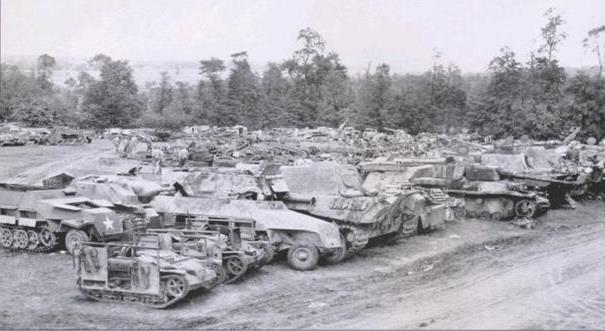
A view of the Isigny depot in Normandy, where captured German armor was collected. The picture shows several German-modified French vehicles along with StuGs, Panthers and Pz IVs.
The purpose of the board, as stated in their report of proceedings, dated 30 July, was:
To conduct tests to determine the effectiveness of tank and anti-tank weapons in First U.S. Army, against the German Mk V "Panther" and Mk VI "Tiger" tanks.
The methodology of their testing was as follows:
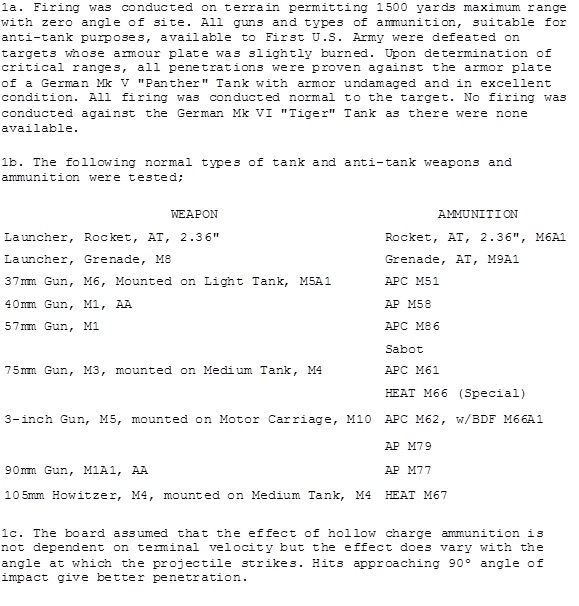
The Isigny test No. 2 was a thorough and well-constructed test, making use of the resources available (a few Panthers with varying degrees of battle-damage) to gather real-word data. The report of proceedings provided credible documentation for its results. An appendix was attached providing photographs and information on the particulars of the various rounds fired.
It is noteworthy that while the board was convened to test US weapons against both the Panther and the Tiger, the Tiger proved, as ever, to be a rare and elusive cat. Given the pressures for real information by the forces in the field, the tests went forward with only Panthers as targets.
Let’s take a look at what the board determined about tank and anti-tank rounds.
First, the 37mm gun:
3) 37mm Gun, M6, Mounted on Light Tank, M5A1
APC, M51 will penetrate the sides and rear of the 'Panther' Tank at 600 yards.
Un-ambiguous and to-the-point. For the 57mm AT gun the story gets a bit more complicated:
5) 57mm Gun, M1
a) APC, M86 will penetrate the sides and rear of the 'Panther' Tank at 1500 yards.
b) Sabot fails to penetrate front glacis slope plate and gun shield at 200 yards. Due to difficulty experienced in obtaining hits no conclusion as to the effectiveness of this ammunition was reached.
Finding 5a is clear. But 5b is a little more complicated. The conclusion indicates that APDS would not penetrate the Panther frontally at minimal range. But the board could not determine the range at which it would penetrate the sides because they quite simply couldn’t hit the target. The conclusion is stated in neutral terms, but represents a growing point of contention. Despite British praises of their sabot rounds, the US Army could not abide by the inaccuracy that they saw with the new British rounds.
Onwards:
6) 75mm Gun, M3, mounted on Medium Tank, M4
a) APC M61 will penetrate the sides and rear of the 'Panther' Tank up to 1500 yards. APC M61 at 200 yards will not penetrate the front armor of the 'Panther' Tank.
b) HEAT M66 (Special) will not penetrate the front glacis slope plate at 500 yards (see assumption made in paragraph 1c).
Seeing that neither the APC shell nor the HEAT round would provide a solution for frontal engagements, the board went on to test the field-expedient alternatives of white-phosphorous (used for smoke screens) and HE rounds:
In addition to testing the normal types of tank and anti-tank weapons and ammunition, additional types were tested with the following results:
A) 75mm Gun, M3, mounted on Medium Tank, M4
WP M64 - Three rounds were fired at 500 yards for the purpose of obtaining an incendiary or blinding effect. The results were unsatisfactory.
B) 75mm Gun, M3, mounted on Medium Tank, M4
HE M48 w/fz T105 - Three rounds were fired at the front glacis slope plate at 500 yards to determine its armor penetrative characteristics. The rounds failed to penetrate, ricochetting from the plate and bursting in the air.
It's worth noting that there was still a psychological effect: Even if the incendiary effect of WP was such that it wouldn't cause the target vehicle to burn, the crewmen inside the vehicle had little way of knowing that: They'd just see smoke out the vision blocks. As a result, WP could knock out German armour by the simple expedient of getting the crews to abandon the tank. You wouldn't want to rely on this as a default reaction, of course, but some hope is better than none at all.
Ordnance had developed both AP shot and AP shell rounds for the 3-inch and 90mm guns. US M62 AP shell rounds were capped, and so are identified as APC in the table, while the un-capped M79 solid shot rounds are listed only as AP. Even though the numerical labels may indicate otherwise, the M79 AP shot rounds were in fact the earlier rounds to be issued, and were generally replaced by the M62 APC shell rounds after the Tunisian campaign..
The most significant information from the testing was the failures of the 3-inch (and hence also 76mm) rounds:
7) 3-inch Gun, M5, mounted on Motor Carriage, M10
a) APC M62, w/BDF M66A1 will not penetrate front glacis slope plate at 200 yards. Will penetrate gun mantlet at 200 yards and penetrate sides and rear of the 'Panther' Tank up to 1500 yards.
b) AP M79 will not penetrate the front slope plate or the mantlet at 200 yards. It holds no advantage over APC M62 ammunition w/BDF M66A1.
The US Army had been convinced that its 3-inch and 76mm guns were the right solution to the German Panzers. So disillusioning was this test result that it prompted comment directly from Eisenhower himself, in his oft-quoted statement: Ordnance told me this 76mm would take care of anything the Germans had. Now I find you can’t knock out a damn thing with it.
Better news was found regarding the 90mm gun:
8) 90mm Gun, M1A1, AA
AP M77 will penetrate front glacis slope plate up to 600 yards, the gun mantlet up to 1,000 yards and the turret up to 1,500 yards.
This gun also had the effects of its HE round tested, demonstrating the processes by which non-penetrating hits by heavy HE could damage a tank’s armor:
C) 90mm Gun, M1A1, AA
HE M71, w/fz M48 - One round was fired at 1500 yards as a ranging shot. No perceptible effect was obtained beyond cracking the welds between the glacis and nose plate and the glacis and side plate for a distance of approximately 12 inches. The corner of the glacis slope plate appeared to have a slight depression as a result of this round.
And finally, the 105mm howitzer with its HEAT round seemed to have enough penetrative performance, if it could ever score a hit:
9) 105mm Howitzer, M4, mounted on Medium Tank, M4
HEAT M67 will penetrate front glacis slope plate and gun mantlet at 500 yards (see assumption made in paragraph 1c).
The board concluded with a set of recommendations for Ordnance:
In view of the above findings the board recommends:
1. That steps be taken by the Ordnance Department to develop armor piercing ammunition of materially higher muzzle velocity and penetrative characteristics for the 3-inch, 76mm, and 90mm Guns, accepting, if necessary, a gun tube life as low as 200 rounds.
2. That upon availability of 90mm APC M82 ammunition in this theater, tests be conducted to determine the effectiveness of this ammunition against the 'Panther' Tank.
3. That consideration be given by the Ordnance Department to the development of a liquid filled incendiary shell capable of igniting the target adjacent to the point of impact, for the 75mm Gun and the 105mm and 155mm Howitzers.
The first recommendation is the key issue. The troops wanted better AP performance from their guns. The British had a 76.2mm gun which could penetrate a Panther, but the US didn’t. The reason was that the British gun used more powder for a higher chamber pressure, and so achieved a higher muzzle velocity. US Army Ordnance had rejected such an approach because high chamber pressures wore out gun barrels. Ordnance was determined to stick to one of the basic tenants developed during the economy-minded inter-war period – that a gun barrel had to have a service life of 2,000 rounds. The commanders in ETO felt that a 90% reduction in barrel-life was justified if it meant guns that could knock-out Panthers.
The Isigny Test No.2 generated multiple cables of correspondence between ETO and the US.
The underlying issue was less bureaucratic intransigence on the part of Ordnance, and more a matter of in-experience. Ordnance continuously developed new anti-tank weapons and munitions, and submitted them for consideration to their “customers”: the Army Ground Forces (AGF), the Armored Command, and the Tank Destroyer Command. These three entities had reports from the French, British, and Russian forces, but only limited direct US Army combat experience (in the Mediterranean region) to call upon. Additionally, with the dramatic expansion of the US Army in 1941-43 the personnel in charge changed multiple times per year. As a result, the feedback was inconsistent and often contradictory.
But now that the troops were back in combat against the Panzers, feedback was flooding in. And it was not good.
Ordnance had prepared for heavier German armor. They had, on their own initiative, developed the 76mm gun, the up-gunned M4, the 90mm gun and the up-gunned tank destroyer (M36). AGF and the Armored and Tank Destroyer Commands had neither requested nor encouraged any of these. But Ordnance had also developed another item that nobody seemed interested in … tungsten cored sub-caliber penetrators for their anti-tank guns. In US Army parlance: HVAP (High-Velocity Armor Piercing). As an aside, the pre-planned up-gunning of M4 should be taken as a further nail in the coffin of the perception that American tanks were not designed to be able to kill enemy tanks.
When the Panther crisis arose in Normandy, and the first Isigny tests indicated that the 3-inch and 76mm guns were incapable of penetrating Panthers frontally at normal combat ranges, Ordnance shipped 1,000 of their experimental T4 76mm HVAP rounds to ETO by air for evaluation. Another round of testing was in order.
12th ARMY GROUP TESTS AT ISIGNY: 20-21 AUGUST, 1944
The second set of tests conducted at Isigny were organized under order of the 12th US Army Group, parent of the US First Army. The matter had escalated.
The testing board was convened on 19 August at the same firing range at Isigny. This set of tests were specifically against Panthers, and were to compare the US 76mm gun and new HVAP ammunition to the British 17pdr. The tests used standard ammunition for both guns, and then explored some board-suggested experiments on alternative loadings.
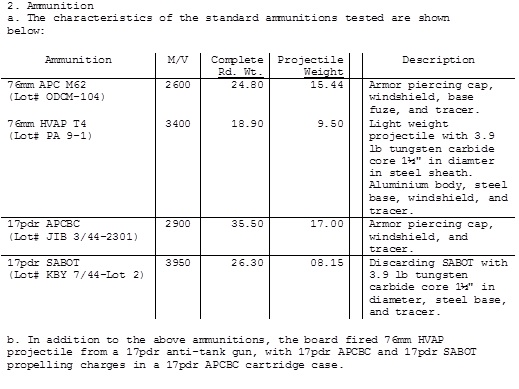
The test firings were conducted on 20 and 21 August. A preliminary report was issued on 22 August, and a final report on 30 August.
Great care was taken to describe the target tanks and the angles presented by the location of the tanks vs. the guns:
3. Nature of Test
a.The above ammunitions were fired at the front plate of three Panther tanks. The general characteristics of the frontal armor are: glacis plate 85mm (3.35") at 55º and nose nlate 65mm (2.56") at 55º. Using US Armor basis curve, the vertical equivalent of the glacis plate is 187mm (7.36") and of the nose plate 139mm (5.47"). Due to the inclination of the ground, the angle with the vertical of the glacis plates on the tanks used in this test were 57º 34', 57º 05' and 56º 53'. The nose plate on one of the tanks tested measured 66.67mm (2 5/8")
This appears to be the first time that an examination of the Panther includes an assessment of the effective thickness of the glacis plate – note the reference to the “armor basis curve”, which suggests that the Panther’s 85mm of frontal armuor at 55º was effectively the same as 187mm of vertical plate, meaning that the Panther’s frontal protection was far in excess of the Tiger’s, and well beyond the penetration of the standard projectiles for the US 3-inch and 76mm guns.
Of note was that the levels of protection provided by the German armor differed from one tank to the next:
b. Wide variation was found in the quality of glacis plate on the three tanks. Tank No.2 (hereafter referred to as the "best plate") sustained 30 hits at ranges from 600 to 200 yards without cracking. Tanks Nos. 1 and 3 (hereafter referred ti as "average plate") cracked after relatively few hits. All conclusions are, therefore, base solely on the relative performance of rounds fired at a single plate. Comparisons are not made between rounds fired at different plates.
This is the first indication that German armor production was producing plates of un-even quality. Later Soviet reports also indicated variance in tests against individual Panther tanks.
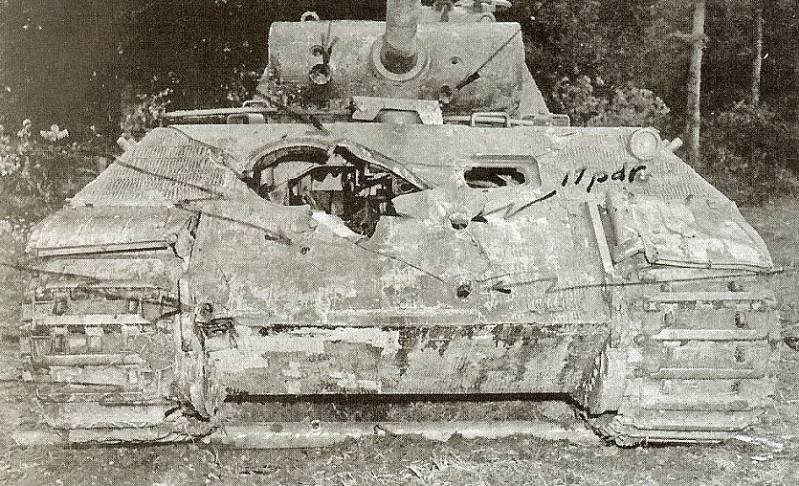 A picture included as an attachment with the report shows one of the 3 Panthers used in the August, 1944 Isigny tests. Note how the plate has shattered around the hull MG bulge – a catastrophic failure indicative of the “edge effect”. This picture demonstrates the difficulty of interpreting firing tests when the shots fired are many, and the targets are few.
A picture included as an attachment with the report shows one of the 3 Panthers used in the August, 1944 Isigny tests. Note how the plate has shattered around the hull MG bulge – a catastrophic failure indicative of the “edge effect”. This picture demonstrates the difficulty of interpreting firing tests when the shots fired are many, and the targets are few.
Whether these were truly due to uneven quality of the armor (the Germans were adjusting the alloy content of their plates to compensate for shortages of some metals), or were due to the degradation of plates that were struck by multiple projectiles in close proximity is hard to asses. The shock waves that propagate through metal from powerful blows can weaken it, even if there is no visible damage or penetration. This is particularly true around the edges of the plate, where the shock waves can compound as they reflect back much like ripples at the edge of a pond of water. Modern tank design focuses on un-interrupted plates with no through-holes (no direct vision ports or hull machine guns) in order to minimize the number of edges in the plate. But the phenomenon of such “edge effects” was not well understood in 1944.
The first test firing at Isigny had indicated some problems with the accuracy of the APDS ammunition for the 57mm AT gun. Evidently this led to some finger-pointing among the allies, as the Americans claimed the rounds were not accurate enough to use, while the British claimed the Americans were simply un-schooled in their use (or, more likely, that they just couldn't shoot straight).
Efforts were made to control for this variable in the second tests at Isigny:
f. The 17pr guns were fired by two superior British enlisted gunners. The 76mm gun was fired by two officers with considerable test firing experience.
Even with trained British gunners, the accuracy of the APDS rounds for the 17pr were strongly called into question by the results.
In the test results of the report, the first issue addressed is accuracy, before the question of penetration is even considered:
b. Accuracy
(1) A tabulation does not present a true picture of the comparative accuracy of the various ammunitions. With all the standard roundfs, except the 17pr sabot, the accuracy was such as to warrant attempting to hit specific parts of the front plates. In general this was successful, but some rounds fired at the lower glacis struck the upper nose, and vice versa. In addition, it was not possible to position all the tanks so that the nose was not, at least partially, hidden by the ground line. Therefore it is felt that a better measure of accuracy can be obtained by considering the nose and glacis as one target.
(2) On this basis all twenty-two (22) rounds of 76mm HVAP, T4, and all twenty-three (23) rounds of 17pr APCBC hit the target. Only one (1) of eight (8) rounds of 76mm APC, M62, which fell short attempting to hit the nose, failed to hit the target. Forty-two (42) rounds of 17pr sabot were fired, and only 57% (24 rounds) were hits. More rounds of 76mm APC, M62 were not fired since its accuracy had been well established in previous firing in the US by two members of the board.
Anti-tank ammunition which was not accurate enough to reliably hit a tank-sized target at ranges of 200 to 600 yards in a range-test with unlimited time, and with no stresses of combat, was not considered acceptable to the US Army.
A British officer who was present compared these results with the results from the earlier Balleroy test firing, and sought to explain the poor accuracy of the APDS rounds seen at Isigny:
The conflict between these results and those obtained by the board is explained by Col. A. G. Cole, Deputy Director of Artillery, Ministry of Supply. Col. Cole witnessed part of the test and states that the ammunition lot furnished the board had not been proof fired. He further states that, in his opinion, the lot is of a sub-standard manufacture and if proof fired would not have been accepted.
Based on this input, the report from the August tests includes this comment in the findings:
The board invites attention to the fact that its findings and conclusions apply only to the ammunition furnished it and may not apply to good quality 17pr sabot.
That was nice of them..
Going back to the available information on the Balleroy test, though, it does not seem obvious that the APDS fired in that test were substantially more accurate than at Isigny. At 700 yards, two “fair hits” on the glacis were obtained out of five rounds fired. Another round struck the joint of the glacis and the lower nose, which by the Isigny standard would have been considered a fair hit too. If the gunners in that test had in fact been aiming explicitly at the glacis for all five shots (rather than at the turret face or the tracks), that suggests accuracy that is reasonably consistent between the two tests.
To put more perspective on accuracy of British APDS at that time, I would note that the British Army’s own test results, obtained by two 17pr-armed Sherman Firefly tanks in September of 1944, were no better. These results and comments were published in Warrant Office Reports WO 291/1263 and WO 165/135 dated 22 September:
400 yds
APC hit 90.5%
APDS hit 56.6%
600 yds
APC hit 73.0%
APDS hit 34.2%
800 yds
APC hit 57.3%
APDS hit 21.9%
1000 yds
APC hit 45.3%
APDS hit 14.9%
1500 yds
APC hit 25.4%
APDS hit 7.1%
These tests were conducted against standard range targets which, for the British Army gunnery the time would have been 6' by 6' – so not quite as large as the frontal aspect of a Panther (which is closer in size to the broad side of a barn). Still, the results show a rather disappointing accuracy for the APDS rounds.
The same WO reports include these comments as guidelines for aiming:
... useful range of APC ammunition was 900 yards while that of APDS was only 450 yards.
... there is no use in attempting to pin-point vital zones in targets at ranges over about 200-300 yards
So despite Col. Cole’s protestations, and the polite statement of findings by the test boards of both Isigny tests, it does not appear that the accuracy of APDS achieved in US Army testing was so far out of line. Rather, it seems to be reasonably consistent with other tests.
In fact only the British embraced APDS with enthusiasm in this timeframe. The US, Soviet and German armies stuck with composite (non-discarding) sub-caliber rounds throughout the war, and the US and Soviet armies continued on through the 1950s, not adopting discarding sabot rounds until the accuracy issues had be unquestionably resolved in the 1960s.
The full findings and conclusions of the board of the August Isigny tests were:
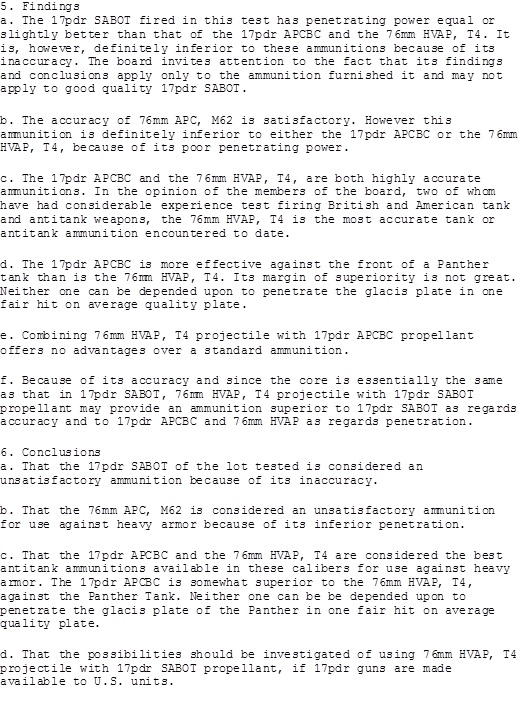
Not particularly reassuring. The best anti-armor round then available to US forces in any quantity, the M62, is rejected as unsatisfactory for use against heavy armor. Two more capable rounds, that are not available to US forces but perhaps could be in the future, the new 76mm HVAP and the British 17pdr APC, are accurate enough but can’t reliably penetrate a Panther. The one round that can reliably penetrate a Panther isn’t accurate enough, even if it were available to US forces.
In the meantime, production of HVAP was ramped up to at least give a fighting chance, and in September the first 90mm-armed M36 tank destroyers were brought into France and issued to TD units.
That isn't the end of the story, however.... Wait for Part 2!















 Update comments
Update comments